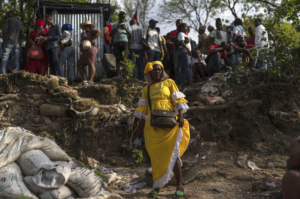Nuclear-armed neighbours swap accusations after clash in disputed Himalayan region
Tensions have escalated between Indian and Chinese forces along their disputed Himalayan border after accusations that shots were fired for the first time in 45 years.
China released a statement late on Monday night claiming Indian soldiers had crossed over the contested border in Ladakh, known as the line of actual control (LAC), and “opened fire to threaten the Chinese border defence patrol officers”.
China claimed it had responded to the “severe military provocation” with unspecified counter-measures.
India was quick to reject this version of events. The Indian army accused Chinese troops of “provocative activities” by attempting to move in on its troops positioned strategically along southern Pangong lake and then firing in the air to intimidate them.

Soldiers fell to their deaths as India and China’s troops fought with rocks
Read more
“Despite the grave provocation, our troops exercised great restraint and behaved in a mature and responsible manner,” the Indian army said. “At no stage has the Indian army transgressed across the LAC or resorted to any use of aggressive means, including firing.”
It was the first time shots have been reportedly fired along the border since 1975, when four Indian soldiers were killed in an ambush.Advertisementhttps://tpc.googlesyndication.com/safeframe/1-0-37/html/container.html
Neither side reported casualties on Monday but the incident marked a further deterioration of the souring relationship between the two nuclear-armed countries, who have been engaged in an increasingly aggressive standoff long their western border in Ladakh.
In May, China was accused of building up troops and artillery along the border and engaging in unusual movements, which India considered to be a violation of its sovereign territory. The situation escalated in Junewhen Indian and Chinese soldiers clashed at high altitude in Galwan Valley in Ladakh, engaging in hand-to-hand combat, which led to the deaths of 20 Indian soldiers.
The two sides pledged to disengage but at least five rounds of military-level talks have failed to resolve the situation and tensions flared again last week, when both sides accused each other of violating sovereign territory. Both sides have sent tens of thousands of troops to the disputed Himalayan border, which sits at an altitude of more than 4,000 metres (13,500ft).
China said the incident happened on the southern coast of Pangong lake in an area known in Chinese as Shenpaoshan. On the Indian side, the area is known as Chushul, where the two countries’ local military commanders have held several rounds of talks to defuse the standoff. Indian and Chinese troops are now said to be within a few hundred metres of each other.https://interactive.guim.co.uk/uploader/embed/2020/09/archive-zip/giv-39021dipOQwHRfnW/
Zhang Shuili, a spokesperson for the People’s Liberation Army (PLA), said: “We request the Indian side to immediately stop dangerous actions.”
India’s external affairs minister, S Jaishankar, who is expected to meet the Chinese foreign minister, Wang Yi, for talks in Moscow this week, described the latest incident as “very serious” and called for a “very, very deep conversation” between the two sides on a political level.

Indians call for boycott of Chinese goods after fatal border clashes
Read more
In 1962, India and China went to war over their border, which stretches over 2,000 miles. For decades, things had remained largely peaceful between the two sides, but there is no sign of resolution of the recent military flare-ups and no signs of disengagement on the ground.
In India, the dispute has led to widespread calls for a boycott of Chinese goods and services and India has banned more than 100 Chinese-made apps.
America faces an epic choice …
… in the coming months, and the results will define the country for a generation. These are perilous times. Over the last three years, much of what the Guardian holds dear has been threatened – democracy, civility, truth.
The country is at a crossroads. Science is in a battle with conjecture and instinct to determine policy in the middle of a pandemic. At the same time, the US is reckoning with centuries of racial injustice – as the White House stokes division along racial lines. At a time like this, an independent news organization that fights for truth and holds power to account is not just optional. It is essential.
Like many news organizations, the Guardian has been significantly impacted by the pandemic. We rely to an ever greater extent on our readers, both for the moral force to continue doing journalism at a time like this and for the financial strength to facilitate that reporting.
We believe every one of us deserves equal access to fact-based news and analysis. We’ve decided to keep Guardian journalism free for all readers, regardless of where they live or what they can afford to pay. This is made possible thanks to the support we receive from readers across America in all 50 states.
As our business model comes under even greater pressure, we’d love your help so that we can carry on our essential work. If you can, support the Guardian from as little as $1 – and it only takes a minute. Thank you.




